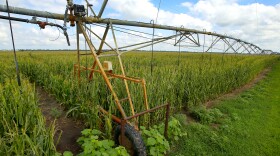Drive across the high plains this time of year, and you see it-- pyramids of white, red, yellow that resemble a sandpainting. Some area farmers, like Mitchell Baalman of Hoxie, Kansas, are putting their money on milo reported Dan Charles for NPR’s The Salt.
"We're learning a lot about milo," says Baalman. "You know, nobody wants to grow milo out here; it's kind of a forgotten crop. But I tell you what, there's where our money's going to be made this year. It'll be on grain sorghum."
There are a number of reasons milo, or in other circles known as sorghum, is a good crop for this region.
· It’s called “the camel of crops” because it uses a third less water than corn.
· It doesn’t wilt and die when the rains don’t come. It waits for the moisture to arrive.
· It grows well in sem-arid tropics.
· It’s nutritious.
· It grows well in soils other plants don’t tolerate.
Milo can be used as high energy feed for livestock, and in the production of corn syrup and ethanol.
Earl Roemer, owner of Nu Life Market in Scott City Kansas, said "Sorghum is naturally gluten-free; it's an ancient grain."
Requests are increasing. "Demand is exploding!" Roemer says. "We're seeing 25 to 30 percent increase in demand, annually. We're doing all we can to increase production." His flour goes into gluten-free baked goods, and is used in breakfast cereals containing so-called ancient grains like quinoa, amaranth and spelt.
Every week, Roemer says, visitors from food companies large and small make the trek to western Kansas to talk about new opportunities. He is also exploring international markets.







